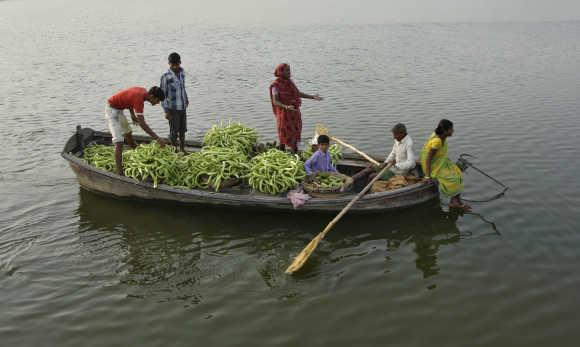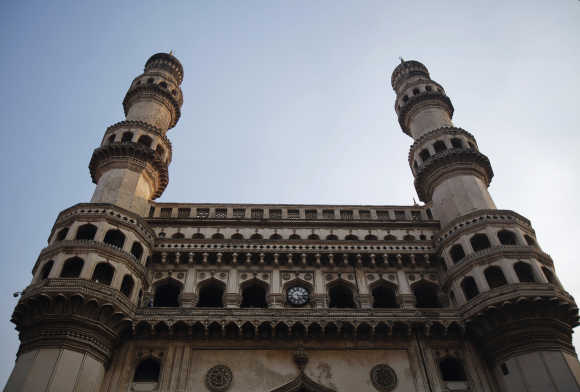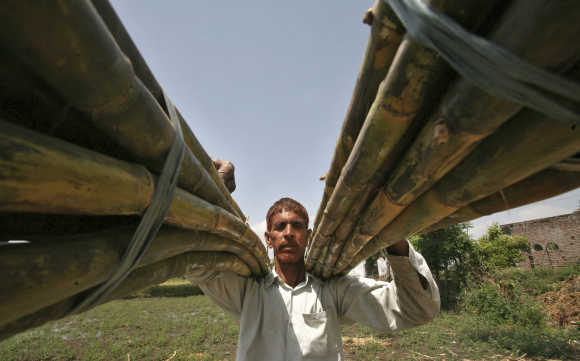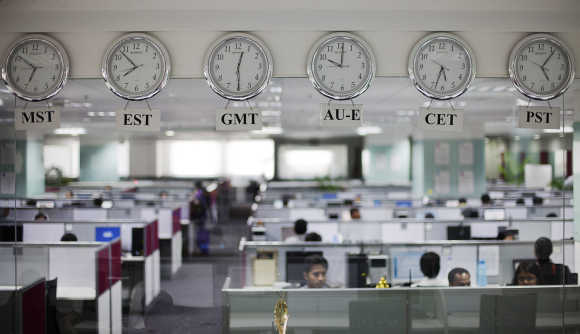 | « Back to article | Print this article |
In four years, India has gone from shining to crawling
What a fall it has been my countrymen (and women). Four years ago India was riding high. We had just completed five unprecedented years of nine per cent average annual growth. Poverty, we now know, had declined substantially, though that seems to displease most of our left-leaning political class (perhaps they think of the poor as vote banks?).
Inflation had averaged hardly five per cent a year. The current account deficit in the balance of payments had averaged 0.5 per cent of gross domestic product. The combined (Centre and states) fiscal deficit had come down to four percent of GDP by 2007-08 from nine per cent five years earlier.
Aggregate investment had risen to a record high of 38 percent of GDP. In international politics the path-breaking civil nuclear deal had been signed and was soon to be validated in Parliament and then the Nuclear Suppliers Group in Vienna, marking a historic end to 34 years of nuclear and technological isolation.
It reflected and enhanced our rising profile in global affairs. No wonder I dubbed these our "halcyon years" (Business Standard, October 9, 2008).
Look at us now.
Click NEXT to read more...
In four years, India has gone from shining to crawling
Economic growth has fallen to below seven per cent. Industrial growth has collapsed. The aggregate investment rate has dropped to 34 per cent of GDP and is headed south, with many large projects stymied by problems of land acquisition, environmental roadblocks and a general policy stasis in the government.
Inflation was near double digits for three years before moderating a bit in recent months. The current account deficit rose above four per cent of GDP, for the first time ever, in the final quarter of 2011 and is likely to be close to an unsustainable four per cent for the full year 2011-12.
With exports having slowed, imports burgeoning, external debt at a new peak and capital inflows skittish, external stress is high and rising. The fiscal deficit and subsidies are, frankly, out of control. The Centre alone showed a deficit of six per cent of GDP in 2011-12 and, with states, the combined deficit is likely to be close to nine per cent, as it has been in the previous three fiscally profligate years.
Nor does last month's Budget hold out credible hopes for a reversal of our macroeconomic woes. The Budget's promise of a modest fiscal correction (less than one percent of GDP) in 2012-13 is critically dependent on reducing the massive subsidies for petroleum products, fertilisers and food.
All of these entail substantial (and long overdue) increases in their controlled prices.
Click NEXT to read more...
In four years, India has gone from shining to crawling
That certainly looks dicey given Mamata Banerjee's well-known opposition to price increases, and her demonstrated capacity for making the central government reverse course: recall the serial capitulations over the Teesta waters agreement with Bangladesh, foreign direct investment in multi-brand retail and, most recently, the debacle over the Railway Budget and change of minister.
Nor is the Budget likely to ignite animal spirits for investment, given its damaging proclivity for "retroactivitis" in tax policy and major expansion of administrative discretion in large swathes of tax administration. The disarray in policy and performance is not limited to the economic domain.
After the prolonged and bizarre legal tussle over the army chief's birth date, last month saw disclosures of attempted bribing of the chief by a recently retired general over a defence contract and the puzzling decision by the chief and the defence minister not to pursue the matter.
Then came news of strange unauthorised movements of military units towards Delhi in January, which were reportedly taken very seriously by the civilian establishment. Perhaps even more damaging was the army chief's leaked recent letter to the prime minister warning of systemic defence unpreparedness in key areas, including tank ammunition supply, artillery and air defence.
If the contents of the letter were seriously inaccurate, how does the army chief still retain the confidence of the government?
Click NEXT to read more...
In four years, India has gone from shining to crawling
And if the letter describes a distressing reality of military unpreparedness for lack of supplies and equipment, then that responsibility rests with the Gandhi-Singh government of the last eight years, especially its defence minister.
In his damning article last week, B G Verghese, the highly respected doyen of Indian journalism, wrote ("India's rotting defence establishment", Business Standard, April 3, 2012), "The disgraceful civil-military crisis India has witnessed denotes complete failure of leadership on the part of the army chief and the defence minister."
He goes on to write: "The larger and far more important issue that must be addressed is the dismaying exhibition of deep systemic and structural rot... Indecision, drift and factionalism, not just on defence issues, have become the hallmarks of governance and politics."
He might have added a reference to the explosive growth in corruption over the past decade, which is now spilling out in the open in many areas, especially those where governmental control and discretion in allocating economic resources remain high. The tragic irony is that despite the unquestioned probity of the prime minister, this government is widely believed to have presided over an unprecedented expansion of corruption in India.
Many strands of history, politics and economics have led to today's sorry state of national affairs. An important one must surely be the novel and peculiar structure of post-2003 governance where the prime minister has been appointed by the head of the dominant party in the ruling coalition and has little, if any, authority over his Cabinet colleagues.
Click NEXT to read more...
In four years, India has gone from shining to crawling
The Westminster model of parliamentary democracy depends critically on the prime minister's power to appoint and sack his ministers. Manmohan Singh has clearly lacked that crucial authority, which has been wielded by the Congress president, Sonia Gandhi.
So, as many have noted, he has the formal responsibility for the government's actions but is bereft of real political power. She has the power but not the responsibility. After eight long years, it is painfully evident that this peculiar form of diarchy has served India ill. It has utterly undermined the principle of Cabinet responsibility.
Ministers have felt free to run their ministries as autonomous fiefdoms. The less scrupulous have exploited such freedom to extort huge rents from governmental decisions in their domain. And let the devil take the hindmost, in this case the people of India and their collective national interest.
So where do go from here? There is no silver bullet. Ultimately, in a democracy, people get the government they elect. Some say they get the one they deserve! I hope we Indians deserve better...
The author is Honorary Professor at Icrier and former Chief Economic Adviser to the Government of India.
These views are personal





